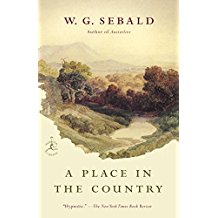A Place in the Country, W.G. Sebald, 1998, Translated 2013 by Jo Catling
A collection of related essays in which Sebald pays tribute to his artistic ideals and role models. Drawing heavily on Walter Benjamin, Vladimir Nabokov, and other sources, Sebald discusses five writers and one artist: Johann Peter Hebel (1760-1826) most famous for his Calendar or Almanac Stories which Sebald admired for its discursive narrative line and use of dialect and old fashioned forms and an unquestioning acceptance of the old order; Jean Jacques Rousseau (1712-1778), the Geneva born philosopher and writer who lived for a time on Ile Saint-Pierre in Switzerland and whose writings about democracy and the natural state of man failed to resolve the contradiction between his utopia and the ‘inexorable march of progress towards the abyss’; Eduard Morike (1804-1875) perhaps Germany’s greatest lyric Romantic poet who was bookended by the French Revolution and the terrors of the ‘new age of industrialization and turmoil unleashed by the accumulation of capital resulting in anxiety and unfulfillment; Gottfried Keller (1819-1890) a Swiss poet and writer of realist German fiction at a time of waning republicanism and increasingly capitalistic bourgeoisie with its inequities who wrote about transience, unrequited love, and depression; Robert Walser (1878-1956), a Swiss born German writer who is seen as the heir to Kafka and who similarly ended up mad and admired; and the painter Jan Peter Tripp (1945- ) a contemporary and friend of Sebald and a collaborator on various works whose slightly askew portraits convey a sense of disquiet and the ‘abyss’ beneath the surface. In each of these essays, Sebald is addressing his central issues of time, memory, the unhappiness and misfortunes of writers and artists, and the depressing direction of man in the 19th and 20th C. The prose style is his typical beautiful, flowing, digressive, and connecting self and the photographs, etchings, and paintings in the book contribute to this overall feeling. “Since then I have slowly learned to grasp how everything is connected across time and space, the life of the Prussian writer Kleist with that of a Swiss author who claims to have worked as a clerk in a brewery in Thun, the echo of a pistol shot across the Wannsee with the view from a window of the Herisau asylum, Walser’s long walks with my own travels, dates of birth with dates of death, happiness with misfortune, natural history and the history of our industries, that of Heimat with that of exile.”



